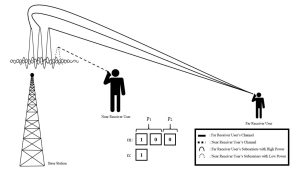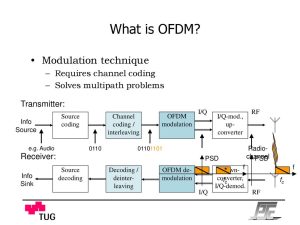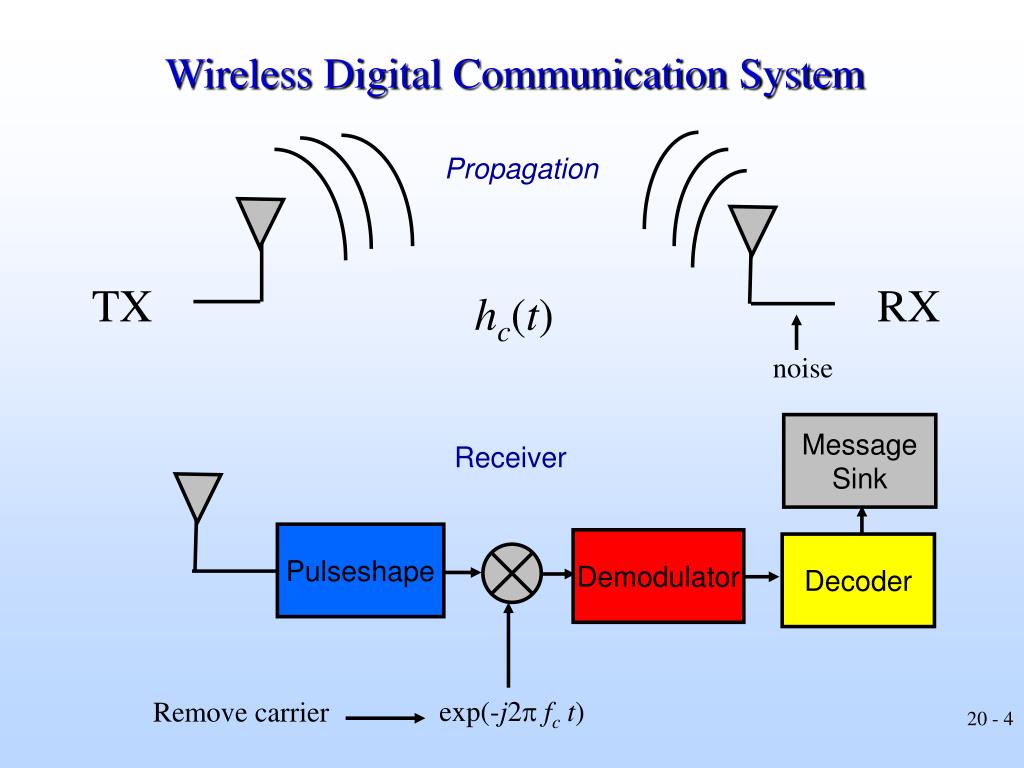The landscape of wireless communication systems has been transformed by the incorporation of cutting-edge modulation techniques, such as Orthogonal Frequency-Division Multiplexing (OFDM) and Frequency-Division Multiplexing (FDM). OFDM, a method that leverages multi-carrier transmission to divide the available bandwidth into a multitude of subcarriers – each carrying a minute portion of data – is particularly noteworthy. The subcarriers are orthogonal to one another, which means they don’t interfere during transmission.

In contrast, FDM splits up the frequency band into several non-overlapping channels, with each channel simultaneously carrying differing signals. Each channel comes equipped with its own carrier frequency and bandwidth allocation for signal transmission. Due to their ability to transmit large amounts of data over long distances reliably, both OFDM and FDM have found abundant applications in various wireless communication systems.
As compared to other modulation techniques like those used in Wi-Fi standards IEEE 802.11a/g/n/ac or Long-Term Evolution (LTE), OFDM’s advantages are numerous: higher spectral efficiency; better resistance against multipath fading and interference; and improved performance in noisy environments. It’s no surprise then that it has become increasingly popular in recent years.
The scope of OFDM extends beyond just wireless communications; technologies like Digital Video Broadcasting(DVB), Power Line Communication(PLC), Digital Subscriber Line(DSL) utilize this technology too which emphasizes its growing importance every day! With ongoing research on emerging technologies like 5G networks or IoT devices underway – it seems likely that we will see even more uses for OFDM blossom soon enough!
Understanding Orthogonal Frequency-Division Multiplexing (OFDM) and its Applications
Contents
- 1 Understanding Orthogonal Frequency-Division Multiplexing (OFDM) and its Applications
- 2 OFDM as a Multi-Carrier Transmission Technique in Wireless Communication Systems
- 3 The Advantages of OFDM in Wireless Communication Systems Compared to Other Modulation Techniques
- 4 How OFDM-Based Communication Systems Adapt to Channel Conditions to Improve Performance
- 5 OFDM’s Use in Digital Video Broadcasting (DVB) and LTE Networks
- 6 The Role of Subcarriers and Guard Bands in OFDM Systems
- 7 The Future of OFDM in Wireless Communication Systems and Emerging Technologies
The perplexing and bursty nature of Orthogonal Frequency-Division Multiplexing (OFDM) makes it a unique modulation technique in the world of wireless communications. By dividing available bandwidth into multiple subcarriers, this system creates an orthogonal environment where individual streams can be transmitted simultaneously without interference – allowing for maximum data rates.

But there’s more to OFDM than just subcarrier division. This innovative technology also offers smaller channel sizes that enable multiple users to connect at once, completely eliminating any possibility of signal overlap or inter-symbol interference (ISI). Such resistance against ISI is critical as it prevents symbols from previous transmissions interfering with current ones due to delays in transmission.
Due to its ability to provide high data rates over a wide area network while minimizing interference between users, OFDM has become widely adopted across various communication systems such as terrestrial digital video broadcasting (DVB-T) and long-term evolution (LTE) networks. Its adaptability is another key feature; receivers based on OFDM can dynamically adjust the number of active subcarriers or their power levels based on feedback received from the receiver side.
In summary, OFDM is an effective technique for improving spectral efficiency and maximizing data rate utilization in wireless communication systems. Its ability to divide bandwidth into orthogonal subcarriers makes it ideal for situations where simultaneous access by multiple users is necessary without causing any interference while providing robustness against ISI caused by multipath propagation.
OFDM as a Multi-Carrier Transmission Technique in Wireless Communication Systems
The enigmatic Orthogonal Frequency-Division Multiplexing (OFDM) technique has caused a stir in wireless communication systems with its revolutionary approach. OFDM’s ingenious method involves breaking down the available bandwidth into numerous subcarriers, each carrying diverse data streams to facilitate efficient use of spectrum resources for high-speed data transfer rates. This cutting-edge technology’s versatility allows allocation of different numbers of subcarriers to users or services based on their bandwidth requirements, making it ideal for metropolitan area network environments where multiple users require sharing limited bandwidth resources.
To further enhance reliability and prevent interference between adjacent subcarriers, guard bands are employed in OFDM systems. Moreover, Multiple-Input Multiple-Output (MIMO) technology is utilized to maximize performance by transmitting several signals simultaneously through various antennas at both ends of the communication link while adjusting amplitude and phase independently.
In addition to these advanced features, guard intervals are inserted between OFDM symbols to reduce the effects of multipath fading and improve reliability even more. In summary, OFDM is a formidable multi-carrier transmission technique that efficiently uses available spectrum resources while providing fast data transfer rates through sophisticated features such as MIMO technology, guard bands, and intervals; making it an excellent choice for applications such as digital video broadcasting and LTE networks among others – one promising future technology in wireless communications industry!
The Advantages of OFDM in Wireless Communication Systems Compared to Other Modulation Techniques
The preeminence of OFDM as a modulation technique in wireless communication systems cannot be overstated, given its remarkable ability to battle the pernicious effects of multipath interference. The ingenious allocation of disparate OFDM sub-channels to distinct users has proven effective in combating intersymbol interference, resulting in superior spectral efficiency while maintaining orthogonality between sub-carriers.
Moreover, the versatility afforded by OFDM is nothing short of astounding as it can be seamlessly integrated with other techniques such as frequency division multiplexing (FDM) and time division multiplexing (TDM). This allows for a dynamic allocation of different OFDM sub-channels based on user demand, thus optimizing resource utilization like never before.
But perhaps one aspect that truly sets OFDM apart from other modulation techniques is its ingenious use of cyclic prefix which serves to surmount inter-symbol interference stemming from pesky multipath propagation. By providing guard bands between symbols, the cyclic prefix ensures that they remain impervious to any disruptions even when transmitted over multiple paths. Such ingenuity makes it possible for reliable transmission rates even under challenging conditions marked by signal reflections and diffraction – an achievement worthy of admiration!
How OFDM-Based Communication Systems Adapt to Channel Conditions to Improve Performance
The intricacies of OFDM-based communication systems are truly fascinating. These systems possess the ability to adapt to channel conditions using a plethora of techniques that enhance their performance. One such technique involves tweaking the power levels of subcarrier signals within a communication channel, resulting in an impressive reduction of peak-to-average power ratio (PAPR). This is imperative as it helps stave off distortion and interference in the signal, ultimately yielding better overall transmission quality.
But wait, there’s more! The potential for OFDM-based communication systems doesn’t end there. They can also optimize spectral efficiency by utilizing subcarriers that are orthogonal to each other. By doing this, multiple signals can be transmitted simultaneously without causing any unwanted interference with one another – imagine how much bandwidth and data rates could skyrocket with this approach!
At times when all seems lost at the receiver side due to high noise or interference levels on particular sub-channels, these remarkable communication systems have an ace up their sleeve: applying more robust modulation schemes like 16-QAM or even 64-QAM modulation for improved error correction capabilities. Such adaptability is simply mind-blowing!
It’s worth noting that subcarriers play a crucial role in OFDMA – a multi-carrier approach used by different users who share the same frequency band but are assigned distinct sets of subcarriers within the same channel. With technology constantly evolving and demand for faster data rates increasing day by day, we will undoubtedly witness even more advanced techniques being developed for OFDM-based communication systems capable of seamless adaptation to changing channel conditions!
OFDM’s Use in Digital Video Broadcasting (DVB) and LTE Networks
The enigmatic and intricate world of wireless communications has found a formidable ally in the form of Orthogonal Frequency Division Multiplexing (OFDM). With its unparalleled ability to combat frequency-selective fading channels, OFDM has become ubiquitous in digital video broadcasting (DVB) services. Terrestrial, satellite, and cable TV transmissions all utilize OFDM as their go-to transmission technique. The signal is split into multiple sub-carriers that are orthogonal to each other in the frequency domain. This allows for an astute use of bandwidth while eliminating any interference between adjacent sub-channels without requiring inter-carrier guard bands.
In LTE networks, both uplink and downlink transmissions also rely heavily on OFDM’s flexibility to allocate radio resources dynamically based on user demand. The available spectrum is divided into narrowband subcarriers which can be assigned with ease according to usage requirements. Channel estimation techniques are then applied individually per subcarrier resulting in a personalized adaptation method based on channel conditions.
The most significant advantage that OFDM brings to the table for these applications is its proficiency at mitigating interference or attenuation within particular ranges of frequencies. By breaking up the signal into carriers within affected ranges only those carriers require correction rather than affecting every carrier simultaneously leading towards robust modulation compared to single carrier schemes like QAM or PSK which suffer from greater susceptibility toward selective fading effects.
Looking beyond DVB and LTE networks we find Wi-Fi systems utilizing this innovative approach alongside direct-sequence spread spectrum (DSSS), FHSS (frequency-hopping spread spectrum), and IR-UWB (impulse-radio ultra-wideband). As new technologies such as 5G NR make their way onto commercial markets shortly, we can expect further advancements utilizing this powerful multi-carrier transmission approach!
The Role of Subcarriers and Guard Bands in OFDM Systems
OFDM systems are a perplexing and bursty marvel of wireless communication technology. Subcarriers, those integral building blocks of OFDM signals, work in tandem with guard bands – empty spaces between subcarriers – to prevent interference from adjacent carriers. But did you know that these subcarriers can be disabled or slowed down individually to adapt to channel conditions? This enables more efficient bandwidth utilization by allocating resources where they’re most needed.
Moreover, OFDM’s spatial diversity capabilities allow it to receive signals from multiple transmitters without causing interference between them. By carefully assigning power levels and frequencies across all transmitting devices using a limited number of subcarriers spread out over a wide frequency range, coverage area is increased while overall performance is optimized.
In conclusion, the intricacies of how OFDM uses both subcarriers and guard bands confound even the most seasoned wireless communication professionals. However, by leveraging adaptive transmission techniques on each carrier frequency and enabling simultaneous reception from multiple sources sans interference, OFDM boasts unparalleled data throughput capabilities and reliability improvements for wireless networks.
The Future of OFDM in Wireless Communication Systems and Emerging Technologies
The perplexing and bursty nature of OFDM has been lauded as a robust and efficient multicarrier transmission technique in wireless communication systems. It’s no surprise that this technology has been embraced with open arms across various frequency bands, including the likes of digital video broadcasting (DVB) and LTE networks.
But what really sets OFDM apart is its ability to adapt to fluctuating channel conditions, thereby ensuring high data rates even in the harshest environments. This makes it an ideal choice for applications requiring reliable connectivity over long distances or under adverse weather conditions – truly remarkable!
With emerging technologies continuing to gain momentum, it’s only natural that OFDM will play a pivotal role in shaping their development. Its flexibility and scalability make it perfect for IoT devices all the way up to autonomous vehicles! As more devices become wirelessly connected, there’s an increasing need for secure communication protocols that can handle massive amounts of data without compromising on reliability.
OFDM has already proven its mettle time and again with ongoing advancements poised at taking innovation in wireless communications into uncharted territory – now THAT’S something worth pondering!


